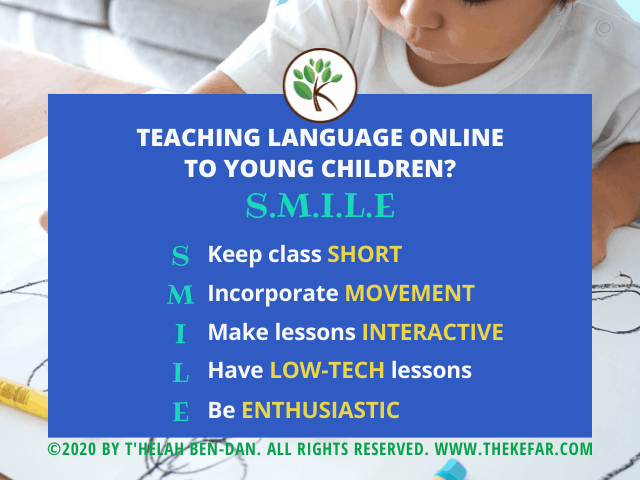S – Keep your lessons SHORT.
Think about how tough it is for many adults to sit through an hour-long meeting; if it’s a struggle for us, then it’s definitely going to be a challenge for young ones. If at all possible, keep your online language lessons for young children to 25-35 minutes in length.
M – Keep your students MOVING.
Provide opportunities for movement throughout the online language class, every 5-7 minutes or so. It gives young children much-needed breaks and encourages them to move around, while still offering valuable language input. You can stand up and stretch together, or do jumping jacks while counting from 1-20. You can sing and dance to your language’s version of “If You’re Happy & You Know it,” or of course any suitable song native to the language you teach. You can play a round of the traffic light game, or “Stand Up If” to review colors or clothing. Let your students be a little silly, let them laugh, let them tumble around a bit; if you’re worried about losing them, it helps to set a timer they can see and hear (share your screen) to help them self-regulate, and get back on track.
I – Keep your lessons INTERACTIVE.
Along with movement breaks, keeping your online language classes interactive helps keep young children engaged, and combats their restlessness. (It also helps the time go by, which is especially helpful when you’re teaching multiple classes a day. Teaching online can be just as exhausting as teaching in person!) As some examples, you can teach a song with movements, have students react each time they hear a word or phrase from a story you’re reading, or frequently pause a video to ask questions, make predictions, describe the scene, etc. You can also incorporate simple worksheets or household items; just be sure to communicate to parents early and often about what’s needed so they have ample time to prepare (and have an alternate plan, because you will inevitably have a few students who won’t have what’s needed).
L – Keep your lessons LOW-TECH.
It might seem a little ironic to say that online language lessons should be low-tech, but you don’t need to incorporate multiple ed-tech tools when teaching young children. I don’t require my young students to access any site other than our virtual meeting platform. Valuable learning time is often lost on trying to get different virtual games up and running, and parents and guardians are not always immediately available to help children navigate from one site to another. It’s best to keep it simple by screen sharing any extra content that you want your students to see.
E – Be ENTHUSIASTIC.
Enthusiasm is SO important! Young children are often very energetic – which you know, having taught them in class – and a little bit of enthusiasm from you goes a long way. During this COVID-19 pandemic, many young children are dealing with fears and anxieties, and the joy you bring to the online language class can help them cope, even if it’s just for a short while. Beyond that, smiles and positive energy just make for a better learning experience, and it’s easier for young children to buy-in to learning online when their teachers are passionate and enthusiastic.

When you’re preparing your online language lessons for young children next week (or this week), remember to S.M.I.L.E (and also smile!). Keep your lessons short so they’re manageable for young learners; incorporate movement breaks to keep children energized; make your lessons interactive so children stay engaged; have low-tech lessons that don’t require children to navigate to multiple sites; and be enthusiastic – that positive energy is contagious!
Let me know in the comments about the successes + challenges you’re having teaching young children online!
Until next time, keep teaching + thriving 💙

Online Language Activities for Teaching Family Vocabulary
If you're wondering about ideas to teach about family or family member vocabulary in your online language classes, this post is for you! It's not an exhaustive list, of course, but there are several tried and true activities you can use when teaching language online,...

Teaching Language Online With Wordwall
This is the second post in my Teaching Language Online With... series, in which I share a tech tool that I use either in my online Hebrew classes, or to prepare materials for my students and courses. (You can find the first post, on Classkick, here.) The posts will...

